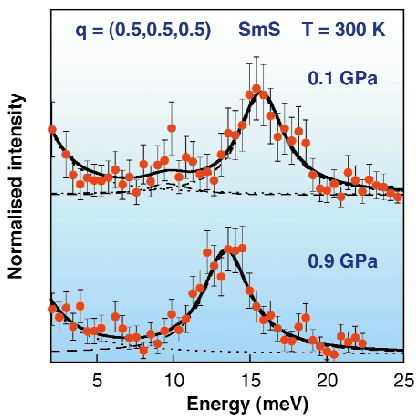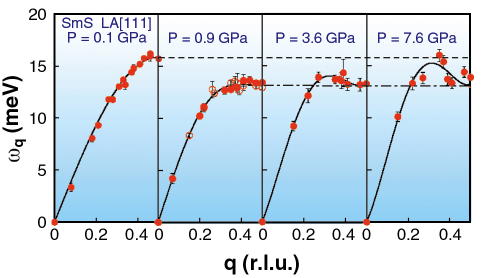- Home
- Users & Science
- Scientific Documentation
- ESRF Highlights
- ESRF Highlights 2002
- High Resolution and Resonance Scattering
- Phonon Anomalies at the Valence Transition of SmS: An Inelastic X-ray Scattering Study Under Pressure
Phonon Anomalies at the Valence Transition of SmS: An Inelastic X-ray Scattering Study Under Pressure
The interplay between charge, lattice and magnetic degrees of freedom is at the heart of modern condensed matter research. Pressure is a unique tool to tune the different couplings between these quantities. The recent advances in research on pressure-induced superconductivity near a quantum critical point stresses the significance of the role of spin fluctuations [1]. Here we are going to concentrate on the role of charge fluctuations, about which very little is actually known. For this we have reinvestigated intermediate-valence compounds where these fluctuations are at their strongest, in particular the case of SmS. At ambient pressure, SmS is a semiconductor with a divalent Sm2+ ionic configuration (black phase). It undergoes a first order isostructural phase transition to a metallic phase (gold phase) at 0.65 GPa. In this phase, the Sm ion has an intermediate valence achieved by promoting a 4f electron into the conduction band, schematically written: Sm2+  Sm3+ + 5d. This leads to a volume reduction of 15% at the transition, and to strong anomalies in the phonon spectrum. These anomalies are reported by inelastic neutron scattering (INS) studies performed under pressure [2].
Sm3+ + 5d. This leads to a volume reduction of 15% at the transition, and to strong anomalies in the phonon spectrum. These anomalies are reported by inelastic neutron scattering (INS) studies performed under pressure [2].
The combination of the diamond anvil cell (DAC) technique and inelastic X-ray scattering (IXS) permitted us to extend the previous INS study to much higher pressure while keeping good crystal quality. The IXS measurements were carried out on a single crystal platelet of SmS placed in a DAC on the beamline ID28 using the constant final energy 17.794 keV (given an energy resolution of 3 meV). The spectra measured on both sides of the valence transition at P = 0.1 and 0.9 GPa at the [111] zone boundary (ZB) are shown in Figure 65.
 |
|
Fig. 65: IXS phonon spectra of SmS measured at q = (0.5, 0.5, 0.5) at P = 0.1 and 0.9 GPa. The lines are fits to the data. The dotted line corresponds to the central diffuse peak, the dot-dashed line to the transvers acoustic modes and the dashed one to the longitudinal acoustic (LA) modes. |
A clear softening of the mode is observed from 15.7 to 13.4 meV. The overall dispersion curves of the LA [111] modes as a function of pressure are shown in Figure 66.
 |
|
Fig. 66: Dispersion relation of the LA [111] branch of SmS for several pressures. |
A softening of the LA [111] mode from halfway and up to the ZB is observed when entering the metallic phase. The anomalous phonon softening effects observed are attributed to the electron-phonon interaction occurring at the valence transition of SmS: the conversion of the 4f electron into the conduction band induces a breathing of the Sm atom that couples resonantly to lattice vibrations. Our IXS study also shows that the ZB LA[111] phonon energy does not evolve further up to 7.6 GPa while a gradual hardening of the low and intermediate q modes occurs in parallel. The fact that the ZB value does not follow the hardening expected when pressure increases is probably linked to an increasing density of states (DOS) at the Fermi level at high pressure in parallel to (or in cooperation with) the change of valence. In this respect, the phonon spectra of SmS at 7.6 GPa is qualitatively similar to the one of the isostructural superconducting compound YS, where a high DOS of d electrons at the Fermi level produces a phonon softening at the ZB. It is well known from the strong coupling theory of superconductivity that soft phonon modes and high electronic DOS at the Fermi level favours superconductivity.
Future studies aimed at finding pressure-induced superconductivity in SmS are encouraged by our results: the large phonon anomalies persist up to high pressure where the Sm has reached its trivalent state (Sm3+). In view of recent works on pressure-induced superconductivity, this superconducting phase may also appear cooperatively or in competition with a pressure-induced magnetically-ordered phase.
References
[1] N.D. Mathur et al., Nature 294, 39 (1998).
[2] H.A. Mook, D.B. McWhan and F. Holtzberg, Phys. Rev. B 25, 4321 (1982).
Principal Publication and Authors
S. Raymond (a), J.P. Rueff (b), M. D'Astuto (c), D. Braithwaite (a), M. Krisch (c), J. Flouquet (a), Phys. Rev. B 66, 220301(R) (2002).
(a) Département de Recherche Fondamentale sur la Matière Condensée, CEA-Grenoble (France)
(b) Laboratoire de Chimie-Physique, CNRS, Paris (France)
(c) ESRF



